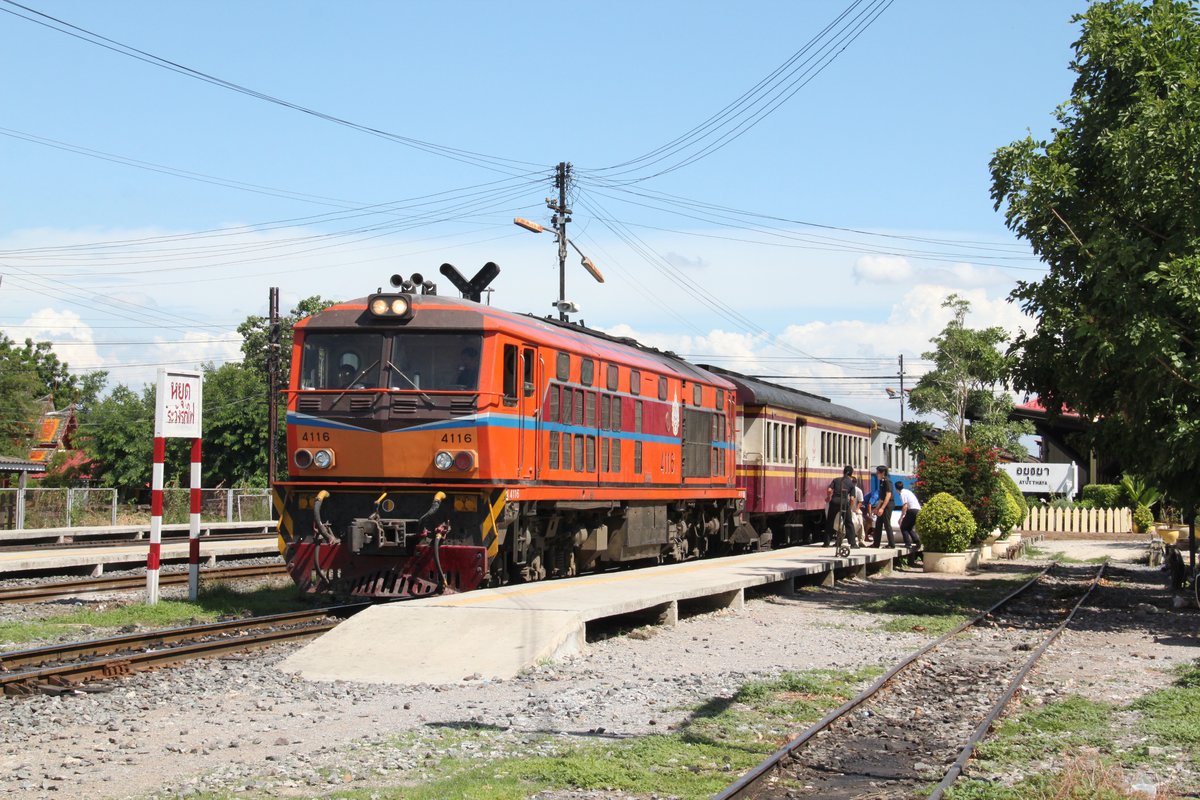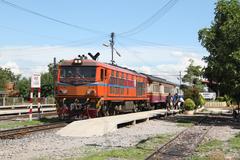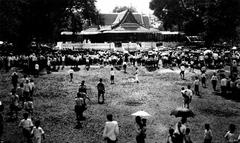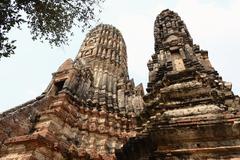
Ayutthaya Railway Station Visiting Hours, Tickets, and Travel Guide
Date: 14/06/2025
Introduction
Ayutthaya Railway Station stands as the principal gateway to Ayutthaya, Thailand’s ancient capital and a UNESCO World Heritage site, seamlessly connecting modern travelers with the region’s rich historical and cultural heritage. Established in the early 20th century, the station links Bangkok to northern and northeastern Thailand, serving as a vital hub for tourists and locals alike (Thai Railways History). Its location—on the east bank of the Pa Sak River just outside the historic island—offers convenient access to Ayutthaya’s renowned temples, palaces, and archaeological treasures. This guide provides essential details about station visiting hours, ticketing, accessibility, facilities, travel tips, local transport, and the station’s evolving role amid Thailand’s high-speed rail development, equipping you for a seamless and enriching visit.
Contents
- Historical Background of Ayutthaya Railway Station
- Architectural Significance and Station Layout
- Practical Visitor Information
- Role in Heritage Tourism and Community
- Train Services, Ticketing, and Station Facilities
- Local Transport and Access to Historical Sites
- Safety, Accessibility, and Travel Tips
- High-Speed Rail Project and Heritage Protection
- Summary and Final Tips
- Frequently Asked Questions (FAQ)
- Sources and Further Reading
Historical Background of Ayutthaya Railway Station
The Birth of Railways in Thailand
Thailand’s railway expansion began in the late 19th century, with the Ayutthaya station becoming a critical stop on the “Korat Line” connecting Bangkok to the northeast (Thai Railways History). The station symbolized modernization, helping revive Ayutthaya as a regional center after its destruction in 1767.
Ayutthaya’s Strategic Role
As the former capital of Siam (1351–1767), Ayutthaya’s riverside location made it a hub for trade and diplomacy (TAT News). The arrival of the railway cemented its status as a transportation crossroads, linking past and present (Train36).
Wartime and Modernization
The station endured significant damage during WWII and was later restored, with upgrades like diesel locomotives and digital ticketing implemented to meet modern needs (Thai Railways History).
Architectural Significance and Station Layout
Ayutthaya Railway Station is characterized by pragmatic early-20th-century Thai railway architecture—open-air platforms, gabled roofs, and the use of wood and concrete (Train36). The design facilitates natural ventilation and accessibility, with three main platforms distinguishing northbound and southbound routes. Its proximity to the historic island and simple, functional style set it apart as a modern threshold to Ayutthaya’s ancient wonders.
Practical Visitor Information
Visiting Hours
- General Hours: Daily from approximately 4:00–5:00 AM to 10:00–11:00 PM, aligning with train schedules (Wikipedia; The Roaming Renegades).
- Ticket Counters: Open throughout operating hours; reduced service late at night.
Ticketing
- Onsite: Purchase at station counters. Ordinary and rapid trains do not require advance booking, but express and special express services do—especially during weekends and holidays (Thai Train Guide).
- Online: Book through 12go.asia or the official SRT portal.
Accessibility
- Station: Ramps and flat surfaces available; some areas may need assistance due to uneven paths.
- Trains: Not all trains offer step-free boarding—staff assistance is available upon request.
Travel Tips and Best Times
- Visit between November and February for cooler weather.
- Early morning trains are less crowded.
- Avoid weekends and holidays for a quieter experience.
- Bring small cash for ferries, tuk-tuks, and snack vendors.
Role in Heritage Tourism and Community
Ayutthaya Railway Station is the gateway to the UNESCO-listed Ayutthaya Historical Park, placing visitors within easy reach of iconic ruins like Wat Phra Si Sanphet and Wat Mahathat (Patrick Le Petit PDF). The station supports local businesses—from tuk-tuks and bike rentals to riverside eateries—and sustains the area’s vibrant tourism economy (The Lone Escape).
Train Services, Ticketing, and Station Facilities
Train Types and Ticket Prices
- Ordinary & Commuter Trains: Basic, third-class, 15–20 THB, 1.5–2.5 hours from Bangkok (Thaiest).
- Rapid & Express Trains: Faster and more comfortable, 65–241 THB.
- Special Express: Premium, up to 350 THB (Nomadicated).
- Tourist/Excursion Trains: Steam excursions on select holidays (Thai Train Guide).
Facilities
- Ticket Hall: English signage, clear platform information (The Roaming Compass).
- Waiting Area: Covered and ventilated; basic seating.
- Restrooms & Café: Available; bring tissues.
- Left-Luggage Service: Daytime only (Thailandee).
- ATMs: Near entrance; currency exchange is limited.
Local Transport and Access to Historical Sites
Getting to the City Island
- Ferry: 200 meters from station, 8 THB per trip, departs every 15–20 minutes (Thailand Redcat).
- Tuk-tuks: 150–300 THB per trip/hour; negotiate fare (Touropia).
- Motorcycle Taxis: From 20 THB.
- Minivans/Buses: Connect Bangkok and Ayutthaya (50–100 THB) (Autour Asia).
- Bicycle/Scooter Rentals: 60–80 THB/day for bikes, 200–300 THB/day for scooters (Voyage Tips).
Exploring the Ruins
- Walking/cycling: Suitable for short distances between sites.
- Tuk-tuk tours: Convenient for seeing multiple temples.
- Boat tours: Unique riverside views, book at ferry pier or guesthouses.
Safety, Accessibility, and Travel Tips
- Stay vigilant against petty theft; beware of unsolicited offers (The Roaming Renegades).
- Prepare for heat and sudden rain; bring water, sunblock, and rain gear (Thaiest).
- Seek free maps and advice at the Tourist Information Office (The Tourist Checklist).
High-Speed Rail Project and Heritage Protection
Project Overview
The Thai-Chinese High-Speed Rail, with Ayutthaya as a key stop, aims to connect Bangkok to Nakhon Ratchasima by 2028 (thailand.locality.guide).
Heritage Preservation
International experts (ICCROM/ICOMOS) have conducted heritage impact assessments, resulting in design adjustments: reducing station height, relocating the footprint, and integrating green spaces to harmonize with Ayutthaya’s historic setting (nationthailand.com).
Visitor Impact and Sustainability
Authorities are preparing for increased arrivals by improving facilities, enforcing visitor limits at sensitive sites, and investing in conservation. Construction updates and visitor advisories are available through official channels.
Summary and Final Tips
Ayutthaya Railway Station is a bridge between Thailand’s illustrious past and its future as a modern, accessible travel destination. With comprehensive train services, practical amenities, and evolving infrastructure, the station offers a smooth entry point to Ayutthaya’s spectacular ruins and living culture. As the high-speed rail era approaches, Ayutthaya is set to remain a vibrant hub—balancing modernization, community vitality, and heritage preservation (nationthailand.com). For the best experience, check operational updates, use travel apps like Audiala for real-time assistance, and embrace sustainable tourism practices (Official SRT Website; Audiala App).
Frequently Asked Questions (FAQ)
Q: What are the visiting hours for Ayutthaya Railway Station?
A: Generally 4:00–5:00 AM to 10:00–11:00 PM daily; check for construction-related changes.
Q: How do I buy train tickets?
A: At the station or online via 12go.asia and the SRT website.
Q: Is the station accessible for travelers with disabilities?
A: Yes, though assistance may be required in some areas.
Q: How do I reach Ayutthaya Historical Park from the station?
A: Use the ferry across the Pa Sak River, then walk, cycle, or hire a tuk-tuk.
Q: Are there luggage storage facilities?
A: Yes, daytime left-luggage service is available.
Q: What’s the best way to get around Ayutthaya?
A: Bicycles, tuk-tuks, and walking are popular for exploring the ruins.
Sources and Further Reading
- Thai Railways History
- TAT News
- Train36
- The Lone Escape
- Thailand Insider
- Thaiest
- The Roaming Renegades
- Thai Train Guide
- 12go.asia
- Wikipedia
- Thailand Redcat
- Nomadicated
- Touropia
- Autour Asia
- Thailandee
- Prachatai English
- Nation Thailand
- Official Tourism Authority of Thailand
- Audiala App


